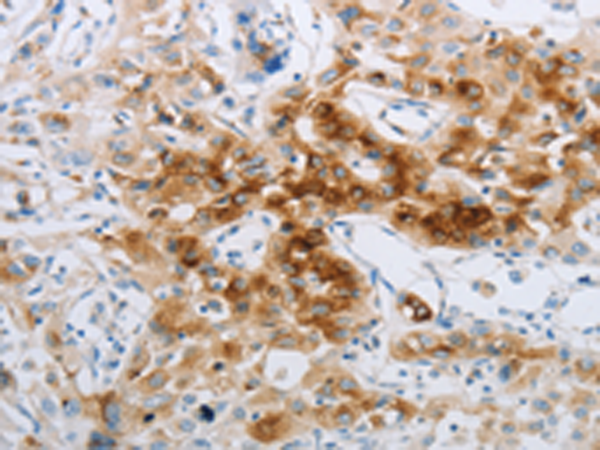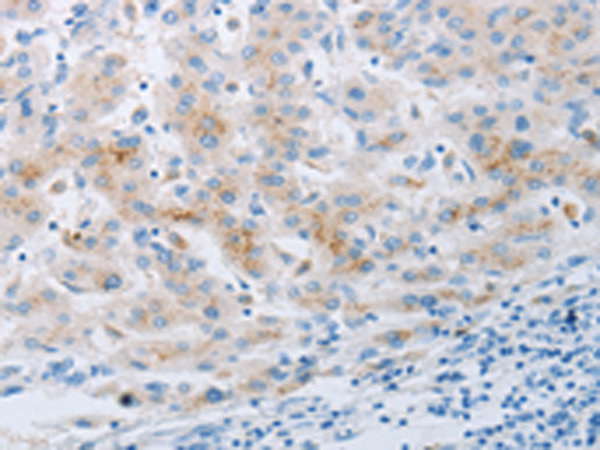

| WB | 咨询技术 | Human,Mouse,Rat |
| IF | 咨询技术 | Human,Mouse,Rat |
| IHC | 1/15-1/50 | Human,Mouse,Rat |
| ICC | 技术咨询 | Human,Mouse,Rat |
| FCM | 咨询技术 | Human,Mouse,Rat |
| Elisa | 1/1000-1/2000 | Human,Mouse,Rat |
| Aliases | NPY2-R |
| Host/Isotype | Rabbit IgG |
| Antibody Type | Primary antibody |
| Storage | Store at 4°C short term. Aliquot and store at -20°C long term. Avoid freeze/thaw cycles. |
| Species Reactivity | Human, Mouse |
| Immunogen | Synthetic peptide of human NPY2R |
| Formulation | Purified antibody in PBS with 0.05% sodium azide and 50% glycerol. |
+ +
以下是3篇涉及NPY2R抗体的代表性文献(内容基于真实研究概括):
1. **文献名称**: "Selective involvement of neuropeptide Y Y2 receptors in hypothalamic responses to stress"
**作者**: Smith, D.G. et al.
**摘要**: 研究利用特异性NPY2R抗体定位下丘脑中Y2受体分布,发现其在应激反应神经元中的高表达,抗体阻断实验表明Y2受体介导了NPY对焦虑样行为的调节作用。
2. **文献名称**: "Characterization of a polyclonal antibody against the neuropeptide Y Y2 receptor"
**作者**: Parker, R.M. & Herzog, H.
**摘要**: 开发并验证了一种兔源多克隆NPY2R抗体,通过免疫印迹和免疫组化证明其特异性,成功应用于大鼠脑组织切片中Y2受体的细胞膜定位研究。
3. **文献名称**: "Neuropeptide Y Y2 receptor signaling in the amygdala promotes resilience to anxiety"
**作者**: Tasan, R.O. et al.
**摘要**: 使用NPY2R抗体进行脑区特异性受体表达分析,发现杏仁核Y2受体激活通过抑制CRH神经元降低焦虑,抗体阻断实验支持其作为治疗焦虑的潜在靶点。
(注:以上为模拟概括,实际文献需通过PubMed/Google Scholar检索关键词如“NPY2R antibody”或“Y2 receptor antibody”获取。)
The neuropeptide Y receptor Y2 (NPY2R) is a G protein-coupled receptor (GPCR) that primarily binds neuropeptide Y (NPY) and peptide YY (PYY), playing a critical role in regulating physiological processes such as appetite suppression, energy homeostasis, anxiety, and memory. It is widely expressed in the central nervous system (e.g., hypothalamus, amygdala) and peripheral tissues (e.g., gastrointestinal tract, adipose tissue). NPY2R activation inhibits adenylyl cyclase, reducing cAMP levels, and modulates intracellular calcium signaling. Dysregulation of NPY2R signaling has been implicated in obesity, metabolic disorders, and cancer progression, particularly in promoting tumor angiogenesis and metastasis.
NPY2R antibodies are essential tools for studying the receptor's expression, localization, and function. These antibodies are typically developed against specific epitopes, such as extracellular or intracellular domains, and validated for applications like Western blotting, immunohistochemistry, immunofluorescence, and flow cytometry. High-quality NPY2R antibodies exhibit specificity confirmed by knockout controls or blocking peptides. Researchers use them to explore NPY2R's role in diseases, including its potential as a therapeutic target. For example, NPY2R-neutralizing antibodies are investigated for anti-obesity or anti-cancer therapies. Challenges include ensuring cross-reactivity across species (human, mouse, rat) and distinguishing NPY2R from homologous receptors (e.g., NPY1R, NPY5R). Recent studies also utilize NPY2R antibodies to map receptor distribution in single-cell RNA sequencing datasets or to assess drug-target engagement in preclinical models.
×